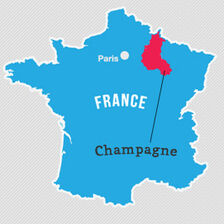The Champagne wine region is a historic province within the administrative province of Champagne in the northeast of France. Now is the moment when you should know that no all the "champagnes"are real champagnes.
Before starting[]
It’s not champagne unless it comes from Champagne, so don’t call sparkling wine from California or Australia (however wonderful it is) ‘champagne’.
Until a couple of years, some American wine-makes made use of a nifty loop-hole in international legislation and shamelessly called their sparkling wine ‘champagne’, thereby infuriating the French.
That is now mostly closed – the argument is too lengthy to detail here, but no decent and respectful wine-maker outside the Appellation of Champagne would call their product, however refined, ‘champagne’. Interestingly enough, champagne is the only wine that does not need to mention AOC status on the label – the mere fact that it is called champagne is enough to confirm it.
What do you call sparkling wine made outside of the Appellation of Champagne in France? It’s generally called ‘crémant‘, though some of the coarser ones may be referred to as ‘mousseaux‘.
Why is Champagne Region peculiar[]
The Champagne winemaking community, under the auspices of the Comité Interprofessionnel du vin de Champagne (CIVC), has developed a comprehensive set of rules and regulations for all wine produced in the region to protect its economic interests. They include codification of the most suitable growing places; the most suitable grape types (most Champagne is a blend of up to three grape varieties, though other varieties are allowed); and a lengthy set of requirements specifying most aspects of viticulture. This includes pruning, vineyard yield, the degree of pressing, and the time that wine must remain on its lees before bottling. It can also limit the release of Champagne to market to maintain prices. Only when a wine meets these requirements may it be labelled Champagne. The rules agreed upon by the CIVC are submitted for the final approval of the Institut national de l'origine et de la qualité (formerly the Institut National des Appellations d'Origine, INAO).
In 2007 the INAO, the government organization that controls wine appellations in France, was preparing to make the largest revision of the region's legal boundaries since 1927, in response to economic pressures. With soaring demand and limited production of grapes, Champagne houses say the rising price could produce a consumer backlash that would harm the industry for years into the future. That, along with political pressure from villages that want to be included in the expanded boundaries, led to the move. Changes are subject to significant scientific review and are said to not impact Champagne produced grapes until 2020.
Regions in Champagne[]
- County of Champagne, medieval principality
- Champagne (historical province)
- Champagne-Ardenne, modern region




